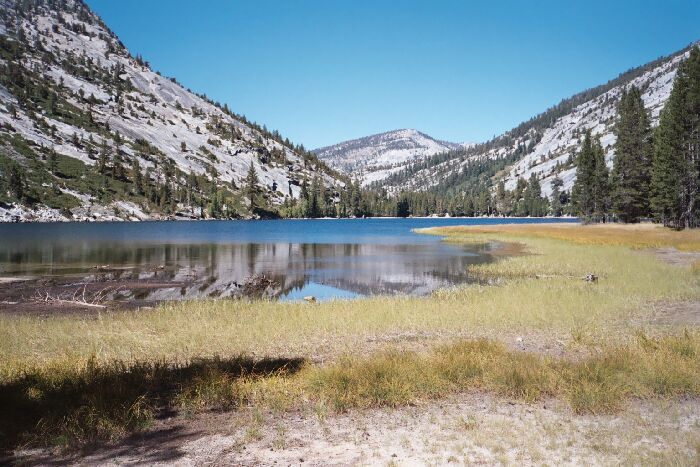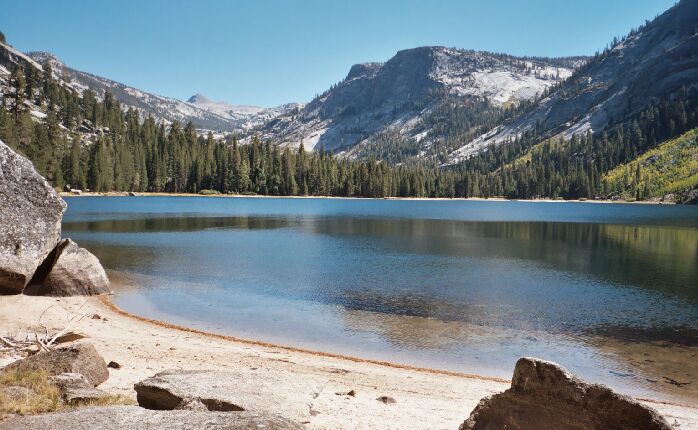
The Ottoway Lakes Loop

The south shore of Washburn Lake near the sandy average camps. Lewis Creek canyon is near mid picture on the right canyon wall.
Washburn Lake
The Ottoway Lakes Loop, September 2004 Eventually I came to Washburn Lake, and I was back on trail I had already done more than ten years ago. I had come down over the Fletcher Creek Trail with my brother and we walked up to this lake to camp. The camp spot was still there and looked about the same (except this time no fire rings anywhere naturally), and other camps I knew about had returned to nature. The one thing I vividly remember other than the splendor of its setting, was at about sunset the entire surface of the lake seemed to be thrashing with hundreds of thousands of feeding fish. I have never seen anything like it. I also remember the cold wind coming off the lake, which it reminded me of when I sat down for a break and some food. Strangely, still no other people there, so the lake was mine if I wanted it.John Muir called this lake "Shadow Lake" and "Nevada Lake", but neither name stuck. For Muir, it was his special retreat, and I would wager the camp I once stayed at was near Muir's favorite camp. Once he was snowed in for a few days at the lake, and after the storm he made bark snowshoes and hiked back to Yosemite Valley. These days, far before anything like that could happen to a hiker, this part of the wilderness would be long abandoned for the season. (Except this year when winter came early in late October and stranded many backpackers.)
Washburn Lake is pretty much a twin of Merced Lake. It sits in a huge granite bowl with a smooth white granite wall on the opposite side of the lake the trail is on, exactly like its 400-foot lower twin Merced Lake. You might argue that Washburn is the better lake because of available camping on the south end and the great views up canyon of the canyon junction and peaks seen from the north end of the lake. From the north end you can get a good look at the Red Peak Fork hanging valley, but no certain idea you could descend that canyon, though I suspect you could.
I decided I did not want to stay there at that lake, although I knew from personal experience that it was a long but fairly easy hike from Washburn Lake to Little Yosemite Valley. I did not care to spend a cold and windy night there, and I wanted to get a jump on the next day of hiking.
 From the north shore of Washburn Lake, looking at the Red Peak Fork canyon on the right canyon wall, and the middle reaches of the Merced River Canyon.
From the north shore of Washburn Lake, looking at the Red Peak Fork canyon on the right canyon wall, and the middle reaches of the Merced River Canyon.
I rounded the lake and the outlet and looked for a camp, just in case, and found a camp that was just not what I was looking for. After a few pictures I headed out, leaving behind vast open views for thick forest. The next 2.4 miles or so were pretty much a grind for a tiring hiker, on trail that ranged from easy to sometimes a bit rough and steep. I passed over an unimpressive soda springs with its questionable smells, slimy red rocks and ooze. Nothing to write home about. When the trail leveled out for good I knew I was in the Merced Lake basin where a shallow lake once filled the area. Now it was flat and meadow filled with lots of trees and tangles of deadfall and bush. At long last the well-developed Ranger Station came into view. I had a good look around, but nobody was home. Everything was locked up tight and awaited some Ranger to come along to tidy up and make sure everything was prepared for winter. Beyond the Ranger Station was the iron signs of the trail junction to Merced Lake and Lewis and Fletcher Creeks trails (Babcock Lake is very nice), and beyond that was two wooden bridges over Lewis Creek. I was about to get water at the second bridge when I looked down the trail and saw what looked like a camp. I walked over, and sure enough, I found a rather nice spacious camp with (can you believe it?!) a fire ring. Not only that, there was deadfall galore everywhere and evidence the camp did not get all that much use. The camp had everything I needed: a nail in a tree for my waterbag, Lewis Creek nearby for water and a bath, some nice stumps and rocks for the kitchen, a nice flat spot to sleep, the area carpeted in pine needles, and all in sparse forest of huge trees providing me with a leafy canopy.
I was lucky to find a tree with a nail. Rangers have a nasty habit of yanking them out or pounding them in, a wrongheaded practice in my opinion. In a park with literally billions of trees, you would think they would not begrudge back/packers a few harmless nails in a few trees in well established near-permanent camps in the vast wilderness. The Rangers don't seem to get too excited when a black bear comes along and claws the crap out of some poor unsuspecting healthy tree, as they often do. This particular mark of man is small and harmless, except to a fanatic. People lose sight of the fact that all of mans trails and camps put together only amount to a few square acres of wilderness as compared to hundreds of thousands of untouched wilderness acres. That fact will not keep some people from overstating the real impact of man on nature (doing crusaders for wilderness preservation no favors), and despite the fact that we are a part of nature, and not a apart from nature. Even good intentions need to be questioned, and not everything is a worst case scenario, or a prelude to it. A nail may be an unnatural thing and alarming to the mind of some, but to the vast wilderness it is of little or no consequence. If another ice age comes along, glaciers will render all preservation debates moot and destroy all the feeble works of man in new creation.
Thinking along these lines I made my no-impact camp, cleaned up, did my chores, and for the second time that trip, I had a rare fire. After a pleasant evening, I let the fire die down and streaked to bed in the very frigid air and blue nearly full moonlight